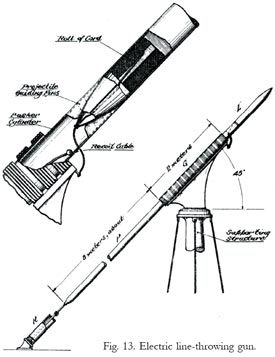
Barry's Coilguns
AC Linear Induction Motor
- Introduction
- Experiment
- Line-Throwing Gun
- Thrust
- Thrust Constant
- Losses
- Traveling Waves
- Resistance
- Capacitors
- Series Parallel
- Energy Storage
- Power Shifting
- Projectile Heat
- Magnetic Field
- Impedance Drop
- About Northrup
- Preface
Electric Line-Throwing Gun
The electric line-throwing gun shown in Fig. 13 illustrates one of the many possible applications of “pusher cylinders.” The essentials of the line thrower are:
- an electric gun G about two meters long,
- a streamlined projectile L to carry the line,
- an extremely light pusher cylinder P about ten meters long, and
- a recoil device R for stopping the pusher cylinder after it has passed through the gun.
In practice, the projectile containing the roll of light cord is fitted
into the end of the long pusher cylinder. The projectile is then
placed in the lower end of the gun. When power is applied, the
projectile and pusher cylinder are thrust upward at an angle of
forty-five degrees.
 As the pusher cylinder is purposely made quite long, the thrust
of the electric gun acts upon it for a period of time
sufficient to
impart the requisite amount of kinetic energy to the projectile. By
allowing enough time for acceleration, the electric gun can produce
great velocities without requiring unreasonable generator capacity,
After the thrust has carried the entire pusher cylinder through
the gun, a knot on a steel cable passing through the cylinder brings
it to a stop. The shock of stopping the cylinder can be absorbed by
a recoil device on the deck or ground. By the use of a net, the
cylinder can be caught and so used again.
As the pusher cylinder is purposely made quite long, the thrust
of the electric gun acts upon it for a period of time
sufficient to
impart the requisite amount of kinetic energy to the projectile. By
allowing enough time for acceleration, the electric gun can produce
great velocities without requiring unreasonable generator capacity,
After the thrust has carried the entire pusher cylinder through
the gun, a knot on a steel cable passing through the cylinder brings
it to a stop. The shock of stopping the cylinder can be absorbed by
a recoil device on the deck or ground. By the use of a net, the
cylinder can be caught and so used again.
The projectile, because of its speed and inertia, leaves the end of the arrested cylinder and starts on its arrow-like flight. The cord coiled within the body of the projectile is paid out behind it through a smooth hole in the tail.
The gun is aimed horizontally by rotating it around a vertical
axis on its supporting structure. The range is adjusted simply by
varying the voltage applied to the terminals of the gun coils, the
gun being normally elevated at a fixed angle of forty-five degrees
with the horizontal.
It is estimated that a twenty-five kilowatt generator could be overloaded sufficiently to deliver the power necessary to shoot a line-carrying projectile to a distance of five hundred meters. As the over-load would not be carried for more than one second, there would be no danger of overheating the machine.
| < Previous | Page 3 of 17 | Next > |
©1998-2024 Barry Hansen